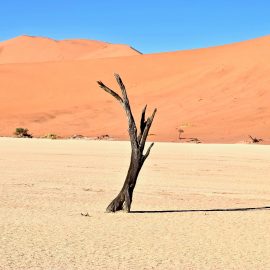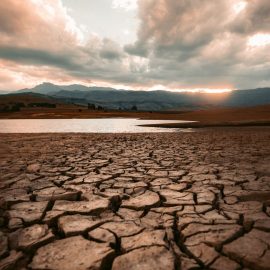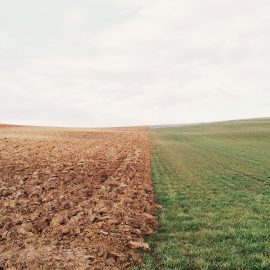Webinars
Upcoming: Droughts and the Post-2015 Agenda
26/11/2020 – 14:00 CET. Free of Charge. LEARN MORE.
Drought, which occurs in nearly all regions, has affected more people worldwide in the last 40 years than any other natural hazard. It is a complex natural phenomenon with varying levels of intensity, duration, spatial extent and impacts. Severe drought episodes have drastic socio-economic and environmental impacts, including, for example, loss of crops, massive famines and migration, natural resource degradation, and weak economic performance. Drought cannot be stopped and is difficult to forecast.
Its impacts can, however, be mitigated through the adoption of a proactive, risk-based management approach aimed at increasing the resilience of communities and societies and their capacity to cope with drought. The scientific findings of the project are delivered by UNU-EHS, in cooperation with the respective partners, through a series of webinars, online lectures and online courses.
Webinars are organized for a more strategy-oriented purpose so they raise global awareness about drought risk reduction and management and stimulate active dialogue and engaging discussion among project partners, relevant international organizations, scientists, students, practitioners, policy makers and the public audience. Online lectures are planned for a more content-focused approach that is based on didactic teaching for different groups of target audience.
GlobeDrought Webinar series is based on 12 learning blocks that will be delivered sequentially. Each learning block covers a topic with three activities including a Webinar, online lecture followed by facilitated forum discussion.
Webinar series

GlobeDrought – Characterizing and Assessing Drought Risk and Drought Impacts at the Global and Regional Level
The first introductory webinar & lecture provide a general overview of the objectives of the BMBF GroW initiative and its GlobeDrought project. It will discuss the relevance of understanding and assessing drought risk and its sectoral impacts in order to create more resilience societies.
The leading questions are: What is a drought, how can it be characterized, why does it matter globally (past events & impacts, future outlook), what is drought risk, what are key components, why do we need to understand and assess drought risk?
26 FeB 2019

Drought Impacts I: Migration
Land degradation and drought are challenges that are intimately linked to food insecurity and migration. In just 15 years, the number of international migrants worldwide has risen, some of which are a result of environmental challenges. Recent trends appear to support the position that drought conditions increase population movements due to land degradation, and the loss of arable land.
The webinar investigates the interlinkage between drought and migration, exploring how drought affects vulnerability and the ability of communities to cope with the impacts of drought.
26 Mar 2019

Drought Impacts II: Gender/Women
Drought can have economic, social, and environmental effects on women in developing countries. Unequal power relations, gender inequalities, and discrimination mean that women and girls are often hardest hit during a crisis and will take longer to recover. Women and girls experience vulnerability differently than men. During times of crisis women’s access to, or control over, critical resources worsens and can lead to exclusion from claiming basic services and rights. As a result women’s and girl’s vulnerability can increase and undermine their ability to cope with the impacts of droughts and other disasters.
The webinar explores how women are affected by drought impacts and how they can develop coping strategies to tackle drought.
30 Apr 2019

Drought Hazards I: Meteorological Droughts
This webinar will provide an overview of different indicators and tools for characterizing, assessing, and monitoring meteorological droughts.
4 Jun 2019

Drought Hazards II: Hydrological Droughts
This webinar will examine indicators and models used for characterizing and monitoring hydrological droughts, which are generally defined as occurring when there is less water than normal in rivers or groundwater.
3 Jul 2019

Innovation: Total Water Storage Change Analysis from GRACE and Hydrological Modeling
This webinar will explore the use of the GRACE satellite mission, potentials and limitations using GRACE for hydrological drought monitoring.
13 Aug 2019

Detecting Drought and Vegetation Health with Remote Sensing
This webinar and online lecture will provide an overview of remote sensing based indices and derived metrics that can be used for characterizing, assessing and monitoring vegetation conditions and drought (impacts) at both regional and global scales.
21 Jan 2020

Understanding and Assessing Risk of Drought Impacts
After learning about impacts of droughts, different types of drought hazards, and ways to detect and monitor them, this webinar introduces the concept of drought risk and shows why it is important and how to assess risk. After a theoretical explanation, the topic is illustrated by two examples drawing on the work of the speakers.
28 Apr 2020

Drought Impacts III: Agricultural Systems
In this webinar, we explain the characteristics and importance of agricultural drought compared to other droughts (e.g. meteorological, hydrological, etc.).
4 Aug 2020

Drought Impacts IV: Food Security
This webinar will discuss the impacts of drought on food security and community. During the webinar, International organization will present relevant approaches that can be used to support affected communities and mitigate drought effects.
17 Sep 2020

Droughts and the Post-2015 Agenda
This webinar will examine the potential for a more coherent and integrated approach to build climate resilience, reduce economic and social losses, and alleviate poverty in drought affected regions of the world.
26 Nov 2020

Innovation: Supplementing Qualitative Data with Quantitative Data (“Humans as Sensors”)
This webinar discusses the innovative use of qualitative DATA in drought characterization. The webinar focuses on how to gather and analyze DATA coming from an informal channel such as: Twitter, social media and newspaper articles.

The GlobeDrought Information System (GDIS)
In this webinar the new GlobeDrought Information System will be presented and discussed.
GDIS objectives, tools, target groups, how to use, data and models to monitor and forecast.



